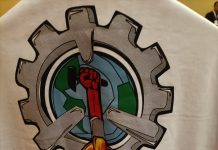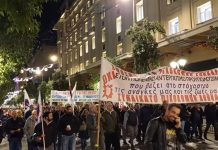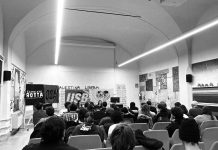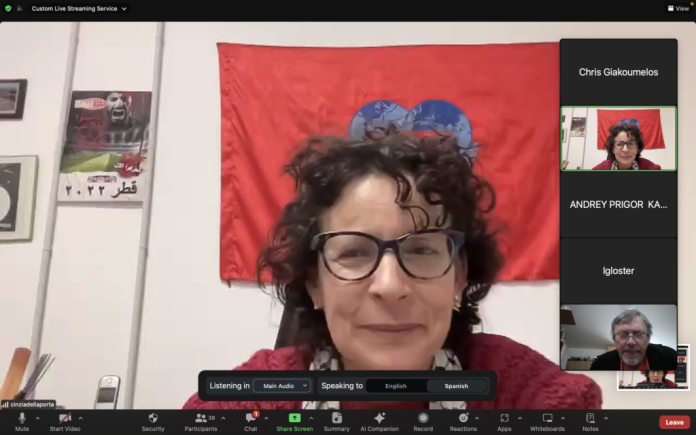The International Workers’ Institute (IWI) has successfully held the 2nd Conference in the framework of the Second Trade Union Educational Cycle on the occasion of March the 8th, International Working Women’s Day. This time, key note speakers have been Prof. Dania Leyva Creagh, member of the IWI Trade Union Educational Committee (TUEC) & Assistant Researcher at the Institute of Philosophy in Havana, Cuba as well as c. Cinzia Della Porta, member of the TUEC and the WFTU Secretariat.
The International Conference focused on the “Role of the Working Woman in the International Class-Oriented Trade Union Movement”. More than 45 international participants, women union cadres honored this militant anniversary from all corners of the world; among them colleagues from Greece, USA, Panama, Cuba, Costa Rica, Czech Republic, Italy, Morocco, Paraguay, India, Senegal, Venezuela, Peru, Puerto Rico, Russia, Colombia, Nepal, Honduras, Ecuador, Guatemala, Kazakhstan, Argentina, Dominican Republic.
You can find below the key note speeches of c. Cinzia and Dania:
Women condition today and function of class oriented trade union movement
[Key Note Speech by cde. Cinzia Della Porta, member of the IWI TUEC & WFTU Secretariat]
First of all, however, I think it is necessary to express our full solidarity with the Palestinian people, victims of a barbaric genocide and an attempt to annihilate them by the Zionist State of Israel, carried out with the chilling complicity of the governments of the so-called Western democracies, including the Italian one, which has also decided to mobilise reservists and is leading the European mission in the Red Sea, sending warships without any parliamentary mandate. The usb has been at the forefront in opposing the Russian-Ukrainian war and denouncing the massacres committed by the Israeli army, and for months it has been blockading Italian ships and airports and carrying out strikes to prevent the transit and departure of ships and planes loaded with weapons. We demand an immediate ceasefire, the indictment of the Israeli government for genocide, the immediate restoration of funding to UNRWA by the states that have stopped it, and the right to a state for Palestine with Jerusalem as its capital.
Working women condition
War, the energy crisis, and the high cost of living widen the gulf of gender inequality, increase poor and underpaid work, exploitation and marginalisation in which women and young people predominantly find themselves.
Precariousness is becoming more and more a condition of life from which it is difficult to break free, while the blackmail of dismissal for women is also associated with the figure of increasing harassment in the workplace and the resignation phenomenon.
There is a close correlation between worsening working conditions, lack of access to employment, economic discrimination and the obstacle course a woman has to take in order to free herself from violent ties and save her skin.
The economic violence that sees the primacy of dismissals of women, compulsory part-time work, the strategy of redundancies disguised as transfers kilometres away from home. That which aims at progressively increasing working hours in the name of unbridled competitiveness for the benefit of a ruling and entrepreneurial class that thinks about grinding profits and squeezing the working class.
The rhetoric of the mother of the family justifies the reduction of services by burdening women with care work. Billions of hours of unpaid work from which to extract incredible economic value.
The defence and reinforcement of the welfare state, as well as the demand for decent working conditions that are not subject to permanent precariousness, and for wages that are in line with the real cost of living, are inalienable conditions.
On the whole, the increase in the presence of women in the labour market has represented and continues to represent an opportunity for capitalism to exploit gender differences as an opportunity to exploit labour and strengthen its domination.
This is evident from the trend in the female labour force, which has grown over the last few decades, datas are different in each country. Example: With pandemic in Italy in December 2020 there were 101,000 fewer employed persons than in 2019 and, of these, 99,000 were women. Even looking at the annual data, this trend is confirmed, with female employment falling by 3.8% between 2019 and 2020, while male employment fell by 2.6%, with a contraction that even in 2021 continued to be more marked for women than for men compared to 2019 (-2.7% compared to -2.3%).
These data are a good representation of the historical trend whereby women’s access to work has always been bound and linked to the needs of capital, fluctuating during periods of crisis when women have greater difficulty in entering and greater ease in leaving the labour market, accentuating the female component of poverty in the long run (the so-called ‘feminisation of poverty’).
Today we speak of the ‘feminisation of work’, a phenomenon that is having clear repercussions on the characteristics and type of work exploitation, as well as on the redesigning of families and cohabitations, social functions and established roles: an element, among other things, to be borne in mind also in the dynamics of family violence, sometimes connected with the loss of the social role of ‘breadwinner’ by the man. A particular aspect of this phenomenon emerged during the pandemic, where the introduction of smart working accentuated the dynamics of overlapping and further exploitation of the productive and reproductive sphere.
Systematising the multiplicity of different components, two ‘type profiles’ of women seem to have emerged at the moment. The army of working women subject to horizontal and vertical segregation, the unemployed, the unemployable and the precarious. And the model of a woman in step with the new productive context: freelance professionals, entrepreneurs, managers, ministresses, commanders and representatives of other high qualifications.
In the current crisis, the level of exploitation of women becomes the measure of the exploitation of so many other categories, but in a tendentially a-conflictual phase, this exploitation is not finding an outlet in movements that conflictually set themselves the goal of improving material living and working conditions. Thanks to their high level of education and the ongoing process of the ‘feminisation’ of labour, women can take on a specific function, in which to invest, in the context of capitalist restructuring of the productive environment: an example is the investment of institutions on digital culture and careers in STEM disciplines (Science, Technology, Engineering and Mathematics), in which women are still under-represented and in which, therefore, margins of exploitation open up that can meet the need for scientific advancement in a sector such as technological innovation that has a strategic value in the intensification of inter – imperialist competition. The canons of bourgeois women’s emancipation become an instrument of propaganda and ideological offensive perpetrated by the imperialist countries both internally, in terms of political and ideological stabilisation, and in terms of global competition and ideological warfare of the west towards the enemy, currently identified above all in China, Russia an Palestine: an element, the ideological one, that risks permeating deep into the mass consciousness, even among the ranks of those who by material conditions should be on the right side of the barricade.
Women have always been a battleground: they are campaign objects, means to be exploited in the profit-oriented society, tools in the clash of civilizations for the “free and democratic” western world. That is why, when the media and political campaign to defend Israel was pinkwashed, we felt no astonishment, but rather only anger. Israel is portrayed as a bastion of democracy and safeguarding the rights of queer people and women in the Middle East against the advance of Palestinian and Arab barbarians, accused of the worst crimes, even “mass femicide”. A pervasive and “easy” mediatic narrative in a country like ours, shaken by gender violence.
A tale, theirs, that uses women to justify genocide and the decades-long Israeli occupation of the Palestinian territories.
A rhetoric that has the flavour of the “ancient” white civilizing mission, now also “feminist,” which makes a distinction between first-class women (ours, Westerners, whites, Israelis) and second- class women (others).
That is why we say: not in our name.
Within capitalism, these elements are then quite relevant on a European scale and assume a particular function in the process of building the European imperialist pole. Faced with the worsening condition of women, the European Union is trying to paint itself pink and set itself up as the champion of women’s rights: the ideological mystification operated on the fate of women serves, however, to actually cover up the ongoing attempt to amplify the internal selection of female labour.
The attempt in progress is clear: to subsume, according to the capitalist restructuring taking place at European and continental level, the key words of women’s struggles by transforming, for example, the concept of equality and equal rights into the liberal concept of ‘equal opportunities’ (of domination…) and emancipation into ’empowerment’. And it is in this context that the investments aimed at women and envisaged in the NRP fit: incentives for female entrepreneurship, funds for work-life balance, incentives for girls’ education and vocational training, especially in STEM subjects. All measures aimed at ensuring an army of current and future female workers chosen to be used in the EU’s restructuring process.
A prospect, from an ideological point of view, of emancipation that is entirely individualistic and individualistic, aimed at creating (for those who make it) women who will exploit other women, invested in roles of power and management, instead crystallising the situation of the majority of women who will feed that ‘reserve army’ of labour that is most exploited or ready to be set aside in times of crisis.
For us in the WFTU, in the class trade union movement, the role of working women is fundamental. The role of women workers in the labour process, in trade unions, in the political struggle, can give additional strength to the class struggles of the present and the future. The class trade union movement has always maintained a firm stand and has consistently fought for equal rights for women workers, for equality at work and in all aspects of life; it has fought for an end to slavery and trafficking in women, for women’s right to vote, for their right to participate in trade unions, in political parties, for their presence in government and state offices, and for women’s participation in social and cultural activities.
Today, in all capitalist countries, working women are subjected to relentless exploitation. They mostly work part-time, temporary and unprotected jobs. They are paid less than men and have access to lower pensions. Working women are the first to be unemployed. In many countries violence against women is on the rise, prostitution and trafficking networks are spreading, economic migration is separating many mothers from their children and husbands. Today, working women have increasingly limited access rights to education, cultural activities and leisure.
When we talk about ‘gender issues’, we are referring to the further exploitation that women suffer in society as a consequence of their gender (i.e. we are talking about a combination of social and gender discrimination). This discrimination has mental, cultural and moral repercussions, as women are prevented from fully and equally developing their capacities. However, the crux of the problem is that these negative effects primarily affect working-class women. On the other hand, middle-class women find the means and possibilities to solve their problems.
Therefore, the solution and the way out lie in the common struggles of women and men against the social system that creates the exploitation of man by man. After all, it is the task of the class struggle of the trade union movement to fight for small and big problems until the final liberation of our class. This has also been the compass that the WFTU has followed, with special consideration and focus on the organic inclusion of women in the struggles of the class trade union movement, not as a decorative element, but as an integral part and condition of the final triumph of the working class.
Class trade unionism does not have only one enemy, the conflict between capital and labour has become part of the conflict between labour and trade unionism accomplice to capitalist and exploitative policies. That trade unionism whose mission is harm reduction rather than the defence of class interests and the struggle to change the capitalist mode of production.
Today we have to bring in our struggles for working women the flags of Palestine
WE WILL NOT BE FREE UNTIL PALESTINE IS FREE – EU governments COMPLICIT IN GENOCIDE
The role of the working women in the class-oriented trade union movement
[Key Note Speech by Dania Leyva Creagh, member of the IWI TUEC & Assistant Researcher at the Institute of Philosophy in Havana, Cuba]
“The campaigns of the people are weak only when the heart of a woman is not enlisted in them; but when she trembles and aids, when the woman, timid and quiet by nature, encourages and applauds, when the educated and virtuous woman anoints the work with the honey of her affection, the work is invincible.” José Martí, a national hero of the Republic of Cuba, envisioned since the late 19th century the role of women in public life from spirituality as an essential part of their nature, seen as a complement to the material strength of men in joining the struggle for emancipation, in the cohesion and triumph of the noblest ideals of humanity.
On International Women’s Day, we feel called upon to reflect on the role of the working woman within the class-oriented trade union movement, in a just tribute to the New York workers who initiated the struggles for their rights and to all women who, in different contexts, under the most difficult conditions, continue to resist and fight.
History reminds us that for millennia, women have faced situations of subjugation, exploitation, inequality, and discrimination in various aspects of society. At the same time, countless events have been led by women demonstrating that their role is not traditionally confined to household chores, but through their struggles, they have managed to integrate into social, political, and economic-labor life. However, this integration has not led to the overcoming of the deep-seated existing gender inequalities and gaps, despite the fact that work is recognized and protected as a fundamental right without distinction based on race, color, or sex.
The labor landscape drawn in recent decades is a natural result of the deepening of the historical contradiction between capital and labor and of the neoliberal policies implemented, which, with new directions, limit the opportunities of working women and have harmful consequences for the sustainability of their lives and those of their families.
This reality unfolds in a changing international context, characterized by the acute crisis (economic, financial, commercial, social, political, ethical, cultural, in short: civilizational) of the capitalist system, which affects all nations without exception. There is also the imperialist military escalation in strategic zones to maintain dominance over the planet’s main natural resources, the expansion of terrorism with its outcome of death, vandalism, and looting, the confrontation between nuclear powers that place humanity on the brink of another world war, the environmental crisis, and in our region, the progressive forces have been forced to confront the counteroffensive orchestrated by the right.
Such challenges call upon social thought, workers, and unionists to demonstrate their full critical, analytical, prospective, and proactive potential, to deepen and make more visible each day the main challenges we face by recognizing that the socio-labor substrate is rapidly changing in the world. This substrate constitutes the basis upon which social subjects are being reconstructed, interacting in the process of production, distribution, exchange, and consumption of material and spiritual goods.
In this regard, it is appropriate to identify what are the current and future challenges of work that affect working women? What impacts do their struggles for emancipation and guarantees of all their rights have? How to ensure that working women join the ranks of class-oriented unionism?
Among the main current and future challenges of work that affect working women are:
– Focus on labor relations
– Double exploitation
– Anti-worker reforms
– Struggles for the satisfaction of their needs
– Full employment, paid and quality work
– Respect for labor rights
– Equitable access to education and professional training
– Closing wage and labor gaps
– Health and safety in the workplace
– Articulating struggles, overcoming fragmentation
The impacts of their struggles for emancipation and guarantees of all their rights relate to:
– Building autonomy
– Having critical thinking
– Involvement in social, political, popular, and community movements
– Generating changes, women are deciding about their own bodies, the right to choose the form of building the family, caring for nature, the environment (Bolivia, Ecuador, and Colombia), animal protection
– Public policies in favor of women
Working women participate in the trade union movement in a limited and conditioned manner due to various causes, related to socio-laboral situation, employment, family responsibilities, and also due to internal functioning of the trade union organization, still notably masculinized in all aspects.
It is established as a trend in practice that unionism is a male-dominated world, therefore, critical awareness needs to be developed, fostering critical thinking about the system of relations between men and women. It is true that the number of women affiliated with unions is lower than the number of men, and the number of women with employment is also lower. Despite this, there is participation of women in unions, albeit with slow progress, as invisibility, exclusion, subordination, and devaluation still limit their actions. Even today, trade unionism and gender are two difficult concepts to associate. Combining class consciousness (discrimination as workers) and gender consciousness (discrimination on the basis of sex) as an indivisible whole is a task that encounters multiple prejudices.
To encourage working women to join the ranks of class-oriented unionism, we should start by:
– Creating spaces for reflection to raise class consciousness, working on subjectivities, to make people aware that the fundamental problem is the exacerbation of the capital-labor contradiction, in other words, creating working-class identity.
– Explaining how the capital-labor contradiction is expressed, its exploitative nature.
– Developing union training programs on gender equality in the workplace.
– Informing about laws and international conventions related to gender to demand compliance in every workplace.
– Promoting in each country the signing or ratification of international conventions related to gender equality (such as Convention 100, 110, 156, 183, and others).
– Strengthening the movement of working women.
– Advocating for the recognition of domestic and care work in a convention.
– Encouraging each country to promote legislation against gender discrimination and take action against inequalities.
In Cuba, the issue of women has been a subject of reflection since 1860. The integration of women into social, political, economic, labor, and community life has been one of the richest and most complex phenomena in the nation’s development over the last 65 years. Nowadays, women are capable of performing the same tasks as men without differences. They are also playing leading roles in various sectors of society. A significant number hold responsibilities and work in important professions such as doctors, architects, engineers, designers, scientists, graduates in legal sciences, history, journalism, and in dozens of other knowledge disciplines. They also play a decisive part in the Cuban Parliament, the government apparatus, the Party, and in entrepreneurship, playing a pivotal role in the construction of the socialist development model currently being implemented.












